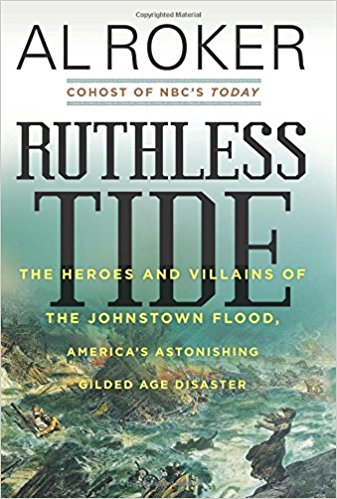Ruthless Tide: The Heroes and Villains of the Johnstown Flood, America’s Astonishing Gilded Age Disaster
- By Al Roker
- William Morrow
- 320 pp.
- Reviewed by Larry Matthews
- June 25, 2018
The celebrity weatherman revisits one of our country’s greatest catastrophes.

No disaster in American history has been written about more than the Johnstown Flood of 1889. Books, articles, first-person accounts, and endless studies have looked at the calamity from every possible angle. Historian David McCullough’s The Johnstown Flood, published in 1968, was considered the final word. So what’s left to say?
Plenty, according to TV weatherman Al Roker.
Roker’s Ruthless Tide offers a hint of what’s to come with its subtitle, The Heroes and Villains of the Johnstown Flood, America’s Astonishing Gilded Age Disaster. Good guys and bad guys populate every page. And we can all agree that a disaster book that opens with the description of an adorable little girl has plenty of dread in store for readers.
In this case, we are introduced to 6-year-old Gertrude Quinn, who, we are told, was scolded on May 31, 1889, for getting her shoes wet in the rising waters that were lapping against her yard in Johnstown. We meet little Gertrude again later; her looming adventures would make Indiana Jones envious.
So, what happened that day? Roker explains the weather system that dumped biblical amounts of water on parts of Western Pennsylvania in late May 1889. It was the perfect storm, so to speak, for the region.
The Johnstown area in that year produced more steel than Pittsburgh and was a hellish place to live. As Roker tells us, “The foundries and steel mills on the riverbanks were going almost all the time. Their fires sending up a perpetual haze of stink and emitting a steady pound and roar.”
As for those who worked in the mills, “Slag piles fell and buried the men, ladles tipped molten steel on them, iron and steel beams cracked their skulls, coal seared them, steam scalded them.” All for 10 dollars a week.
Roker diverts his story by mapping the evolution of Johnstown from a farming community to a canal town to a place that made steel rails, enabling America to grow into an industrial giant. He even throws in the history of steel itself.
But what about poor Gertrude? She disappears from the narrative while Roker takes a few side roads. This is where the book lags.
We soon meet the real scoundrels of the disaster, a group of wealthy industrialists from Pittsburgh. They decide that a beautiful mountain lake would be the perfect summertime diversion; a place where they and their families could frolic, swim, boat, and dress to the nines for dinner in their own private clubhouse.
We’re talking about men like Andrew Carnegie and Henry Frick, who were the masters of American industry at the time. They formed the South Fork Fishing and Hunting Club, bought the land around an old reservoir, and stopped up the South Fork Creek with, as history attests, a shoddy earthen dam.
Even during construction of the dam, experts were warning that it would likely fail during a heavy storm. The South Fork Fishing and Hunting Club brushed aside the critics and assured the world that it was a fine dam. It also sat upstream about 14 miles from Johnstown.
Then it rained. And rained. And rained.
There was no system at the dam to relieve the rising water, which spilled over the top and down its face, causing the whole thing to collapse. The lake that had entertained the swells from Pittsburgh sent 400 million cubic feet of water (about 20 million tons) downstream in what Roker calls “the monster.”
The lake was two miles long and 60 feet deep, and it soon became a hellish wall of brown water carrying houses, businesses, livestock, people, locomotives, and whole forests through communities just upstream from Johnstown. When the monster reached the steel mills, it swept them along. People were trapped against ceilings or crushed in their attics as the surging waves tore their homes from their foundations.
But there was one structure that withstood the onslaught: a railroad bridge so solidly built that it did not collapse as the wave crashed against it. Instead, debris — including houses, churches, and the mangled, drowned bodies of countless victims — collected and pressed against it.
Thousands died in the disaster; thousands more were left with nothing. Children were orphaned, parents were left childless. Husbands lost wives, and wives became widows.
Roker did his research as far as uncovering who these people were. He tells us their stories, good and bad. Parts of Ruthless Tide read like a thriller and will have you turning the pages with a pounding heart. Other sections will send you into a rage against the ultra-rich.
What happened to the South Fork Fishing and Hunting Club? Nothing, even after blame for the disaster was placed squarely on its shoddy dam. Lawsuits were filed and lost. There was public outrage, and the courts began to treat disaster cases differently, but the men who were ultimately responsible for the unimaginable tragedy never lost a dime (although their pristine summer homes now overlooked a sea of mud).
The Johnstown Flood remained in the national headlines for years and remains with us today as part of our heritage:
“Maybe the power it wielded for so many years over the American imagination came from its status as the biggest national story after the Civil War. Maybe the protest against the heedless rich that the flood engendered served as a sign of new times…whatever the factors, and there were probably many, the story of the Johnstown Flood quickly took on a life of its own that would forever set it apart in American popular culture.”
By the way, young Gertrude Quinn would live to write a book of her own.
Larry Matthews is the author of Take a Rifle from a Dead Man.

_80_121.png)